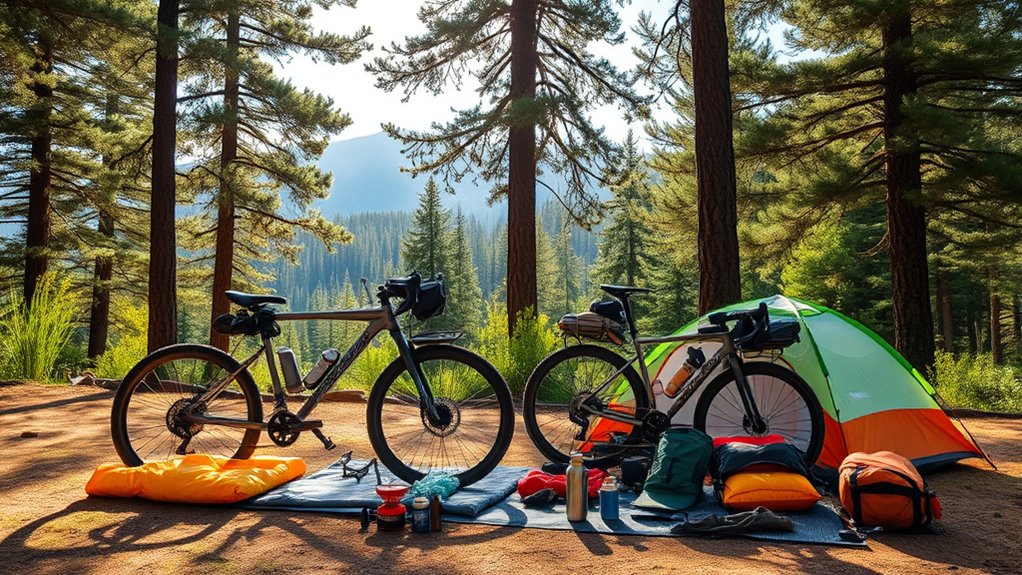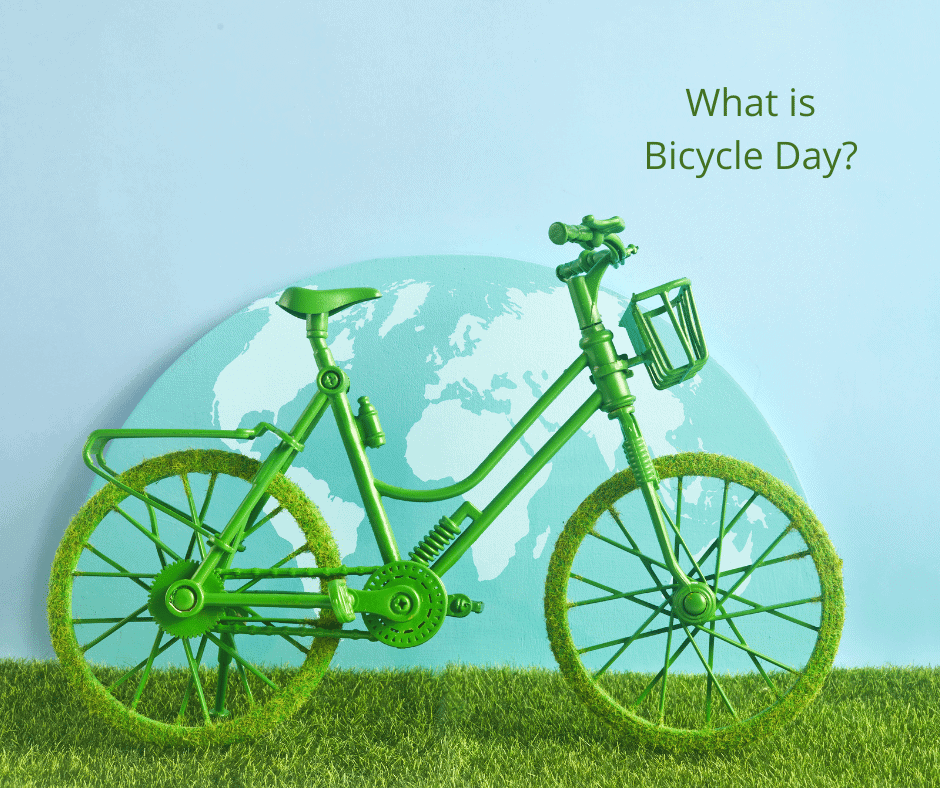For your ultimate bike camping checklist, make sure you pack essential bike gear like a well-fitted bike, helmet, and lights. Include lightweight shelter options like a freestanding tent or hammock. Don’t forget your sleep system essentials, cooking gear, and food management supplies. Bring navigation tools and hygiene items, plus a well-stocked first aid kit for safety. Comfort items can enhance your experience. Stick around to uncover more tips to make your adventure unforgettable!
Key Takeaways
- Ensure your bike is well-fitted and equipped with safety gear like a helmet, headlight, and taillight for visibility on the road.
- Pack a lightweight tent under 2.5kg, along with a quality sleeping bag and pad for a comfortable night’s sleep.
- Bring a portable camp stove, cooking pot, and lightweight utensils for preparing and enjoying hot meals along the trail.
- Organize hygiene essentials like biodegradable soap, toothbrush, and wet wipes, plus secure food storage to protect against wildlife.
- Carry navigation tools like a physical map, GPS device, and portable charger, along with a well-stocked first aid kit for emergencies.
Essential Bike Gear
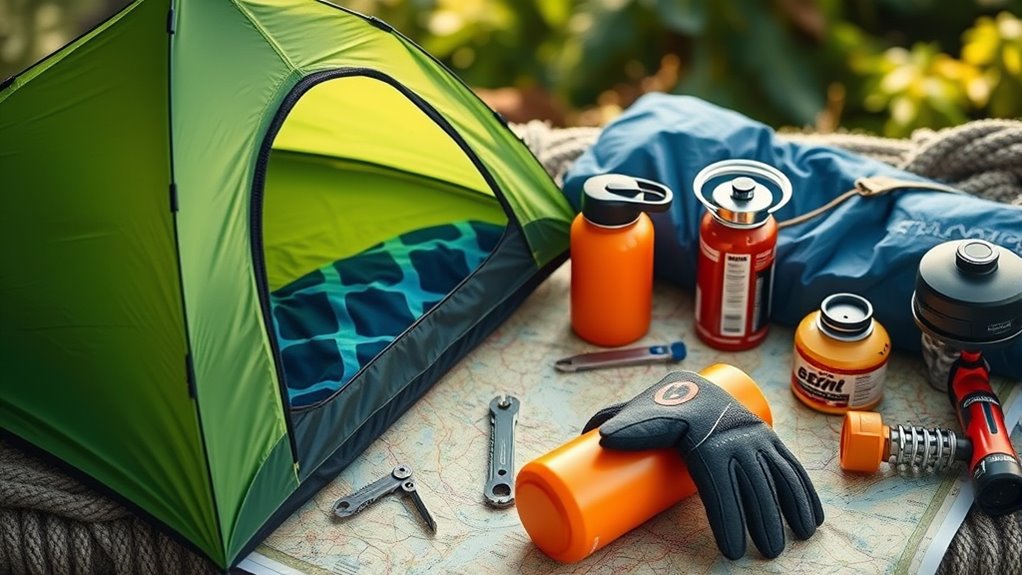
When you’re gearing up for a bike camping adventure, having the right essential bike gear can make all the difference. First, make sure your bike is well-fitted; visit a shop to adjust the seat and handlebars for maximum comfort.
Don’t forget padded bike shorts and gloves—they’ll help reduce chafing and absorb shock on those bumpy trails. Opt for wide tires to boost traction and stability, especially on rough paths.
A low-maintenance bike with a rear rack and bikepacking bags will allow you to carry your camping gear efficiently, distributing weight evenly.
Safety is key, so equip yourself with a helmet, headlight, and taillight to enhance visibility during both day and night rides. Additionally, consider bringing a first aid kit to ensure you’re prepared for any minor injuries that may occur on your journey.
Enjoy your adventure!
Shelter Options

When choosing your shelter for bike camping, weigh your options carefully to find what suits your needs best.
Consider criteria like weight, setup ease, and weather protection, while exploring alternatives like bivy sacks and hammocks for unique experiences. It’s also important to master the art of bug out bags to ensure you’re prepared for any situation while camping.
Let’s break down the essentials of tent selection, alternative shelter types, and some handy packing tips.
Tent Selection Criteria
Selecting the right tent for bike camping is essential for a comfortable experience, especially since you’ll be balancing weight and durability. Aim for lightweight options under 2.5kg to make transport easier while ensuring they withstand harsh weather.
A freestanding design is ideal, allowing quick setup on various terrains without the need for stakes. Look for tents with removable rainfly covers for better ventilation and adaptability to unpredictable weather.
A two-person tent provides extra space for your sleeping gear and gear storage, enhancing comfort during longer trips. Finally, assess how quickly you can set up your tent; with practice, you can pitch it in under two minutes, making your camping experience smoother and more enjoyable. Additionally, consider weather-resistant materials to ensure your tent can endure challenging conditions while you’re out in the wild.
Alternative Shelter Types
While tents are the go-to choice for bike camping, other shelter options can enhance your experience based on your preferences and conditions.
Fast fly setups, combining a rainfly, ground sheet, and poles, allow for quick assembly and are great if you prioritize speed.
Tarps offer versatility with various configurations, remaining lightweight and easy to transport.
If you find yourself in wooded areas, consider hammocks for a comfortable sleep, just remember to bring a rainfly for weather protection and make sure you have suitable trees for setup.
Finally, bivvy sacks are ultra-lightweight, providing minimal protection and ideal for warm weather or emergencies where every ounce matters.
Choosing the right shelter type can significantly impact your overall camping experience!
Choose the shelter type that best fits your adventure!
Setup and Packing Tips
To make your bike camping experience smoother, consider how you pack and set up your shelter.
Opt for ultralight tents under 2.5 kg for easy transport and bug protection. A freestanding tent, like the MSR Hubba Hubba, offers flexibility and ventilation without a fly cover in good weather.
Fast fly setups with a rainfly, groundsheet, and poles allow for quick assembly and element protection. Don’t forget a ground cloth to insulate your sleeping bag and keep it dry on varied terrain.
If you’re going minimalist, consider tarps or bivy sacks to lighten your load while still providing essential shelter. Additionally, using advanced filtration systems can enhance your comfort by keeping your sleeping area free from allergens.
Pack these items efficiently in your bike bags to maximize your space and guarantee a hassle-free adventure.
Sleep System Essentials
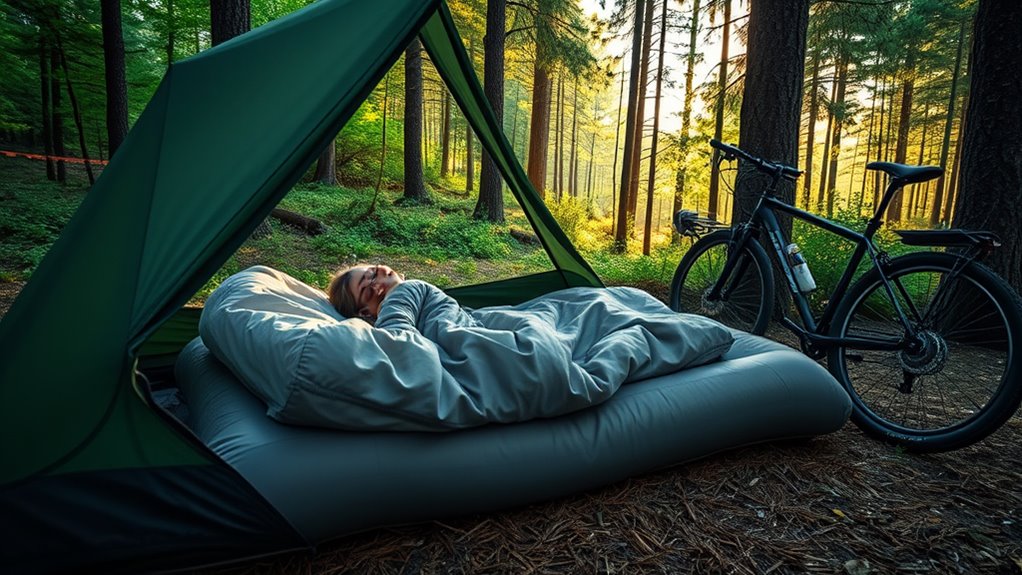
When planning your bike camping adventure, having the right sleep system essentials is crucial for a restful night.
Start with a sleeping bag that matches the temperature ratings for your expected weather, whether it’s a lightweight summer bag or a cozy insulated model for colder nights. Pair it with a quality sleeping pad to provide comfort and insulation from the ground; quick-inflating air mattresses are a great choice.
Choose a sleeping bag suited for your weather and pair it with a quality sleeping pad for optimal comfort and insulation.
Don’t forget an inflatable pillow for convenience, or use a stuff sack filled with clothes as a practical alternative. A ground cloth adds an extra layer of protection from moisture and dirt, while a compact foil blanket can be a lifesaver during unexpected cold nights. Additionally, consider adding natural materials to your sleep setup for enhanced comfort and a more tranquil experience.
Enjoy your sleep!
Food and Water Management

When you’re out bike camping, managing food and water is essential for your adventure.
You’ll want to take into account water filtration options to guarantee safe drinking water and pack efficient food storage solutions that keep your meals fresh.
Plus, having the right cooking gear will help you whip up hot meals, keeping your energy levels up on the trail. Additionally, understanding Leave No Trace principles will help you minimize your impact on the environment during your camping experience.
Water Filtration Options
As you plan your bike camping adventure, ensuring access to safe drinking water is essential for your health and comfort.
Consider portable water filters like the Sawyer Mini or Katadyn BeFree, which effectively remove bacteria and protozoa. For a lightweight option, chemical treatments such as iodine or chlorine dioxide tablets are compact and require a wait time of 30 minutes to 4 hours.
If you prefer speed, UV light purifiers like the SteriPEN can treat a liter in just 90 seconds, though they need batteries. For larger quantities, gravity filters like the Platypus GravityWorks allow you to filter up to 4 liters effortlessly.
Always think about the clarity of your water source and your hydration needs when choosing a filtration method for bikepacking. Additionally, consider using safe materials for toys that can offer insights into safe practices when selecting camping gear.
Food Storage Solutions
Effective food storage solutions are essential for a successful bike camping trip. You’ll want lightweight, durable containers like resealable bags and compact food canisters to keep your food fresh and prevent spoilage while minimizing weight.
For hydration, utilize foldable water bladders that allow you to carry 2-6 liters of water, depending on your route’s water sources. This way, you can easily refill without the bulk of bottled water.
When planning meals, consider dehydrated or freeze-dried options, which offer high energy density and reduced packing volume.
Finally, invest in a reliable water filtration system to guarantee you have safe drinking water from natural sources, so you’re well-prepared for whatever adventure lies ahead. Additionally, be mindful of clear boundaries to protect your food from potential wildlife encounters while camping.
Cooking Gear Essentials
Cooking gear essentials play an essential role in your bike camping experience, ensuring you can prepare meals efficiently while managing your food and water needs.
A portable camp stove, like the MSR Dragonfly, offers easy maintenance and flame control for various cooking tasks.
Don’t forget a lightweight cooking pot, such as the MSR Quick 2 Cooking set, which nests for convenient storage.
Effective water management is key—pack foldable water bladders for easy refills and hydration.
A durable spork serves as a multifunctional utensil, minimizing weight and protecting your non-stick cookware.
Finally, consider a small water filtration system to access clean drinking water from natural sources, enhancing safety and convenience during longer trips. Additionally, ensuring you have essential survival gear can significantly improve your overall preparedness for unexpected situations.
Navigation Tools
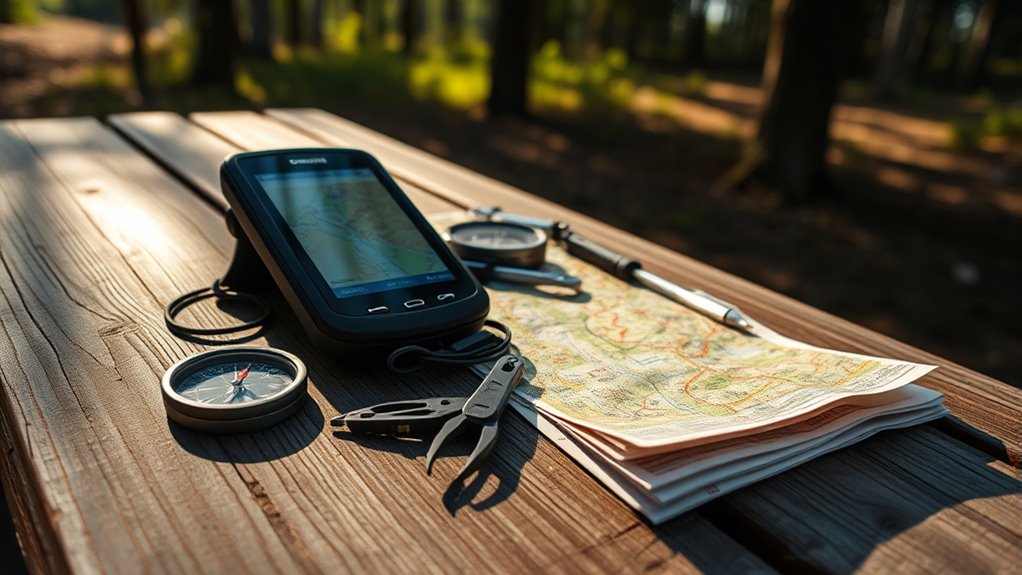
How will you find your way when adventure calls on the open road? For successful bike camping, reliable navigation tools are crucial. Here are three must-haves:
- Physical Map & Compass: Always carry a printed map and compass as backups. They’ll orient you when technology fails.
- GPS Device: This handy tool offers real-time tracking and route planning, simplifying navigation on complex trails or unfamiliar areas.
- Smartphone with Navigation Apps: Enhance your journey with apps, but don’t forget a portable charger to keep your device powered through your ride.
Before you go, research route conditions and hazards to guarantee a smooth ride on your local bike.
With these navigation tools, you’ll confidently explore the great outdoors!
Hygiene and Toiletries
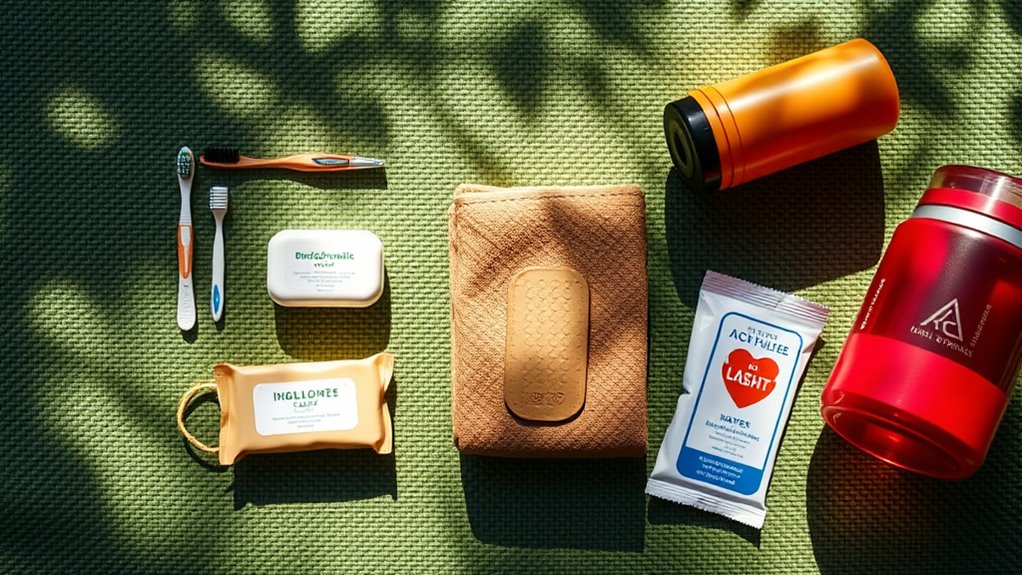
After traversing the trails, you’ll want to make certain that your hygiene and toiletries are in order for a comfortable camping experience.
Start by packing only the essentials like a toothbrush, toothpaste, biodegradable soap, and toilet paper to keep your gear lightweight. Use zip-top bags of various sizes to organize toiletries and waste, ensuring cleanliness and easy access.
Packing essentials like a toothbrush, toothpaste, and biodegradable soap in zip-top bags keeps your camping gear lightweight and organized.
When water is limited, pack wet wipes for quick revitalizing without wasting drinking water. A compact, portable shower bag can provide a rejuvenating rinse in remote areas where showers aren’t available.
Don’t forget lip balm and sunscreen to protect your skin from sunburn and chapping, keeping you comfortable during all your outdoor adventures.
Safety and First Aid Supplies
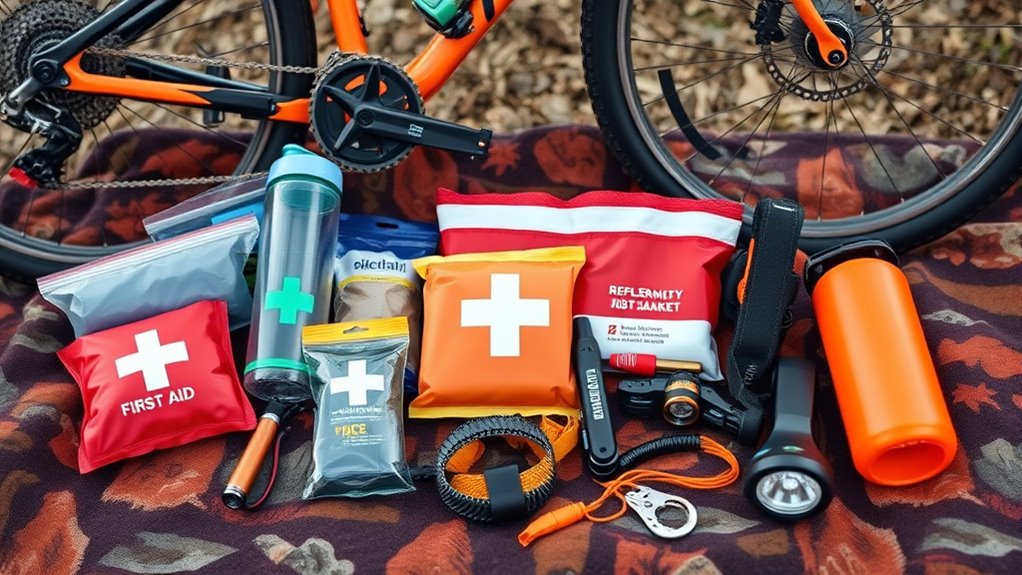
When you’re out on the trails, having the right safety and first aid supplies can make all the difference in your camping experience.
A well-stocked first aid kit is essential to deal with injuries and unexpected mechanical issues. Here are three critical items to include:
- Tweezers – Perfect for removing splinters and ticks.
- Emergency Blanket – Lightweight and compact, it provides warmth during unexpected cold conditions.
- Ibuprofen – Effective for pain relief from injuries, sprains, or inflammation.
Don’t forget to carry a whistle for signaling help in remote areas, and pack allergy relief medications like Benadryl for unexpected reactions.
Being prepared guarantees you can enjoy your adventure while staying safe and healthy!
Repair Kit and Spare Parts
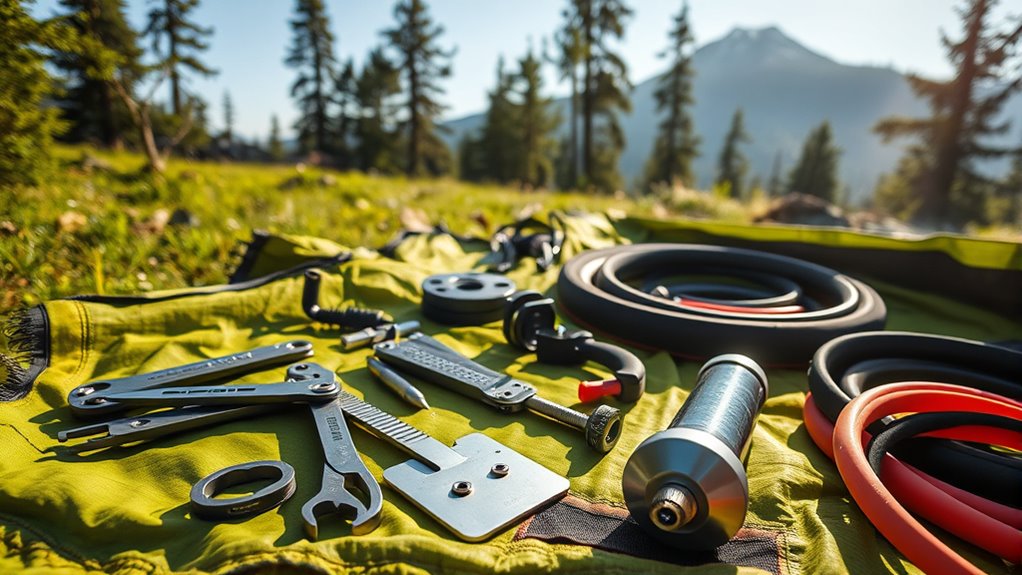
Having a well-equipped repair kit and spare parts can be a game-changer during your bike camping adventure.
Your repair kit should include tire levers, a multi-tool, spare tubes, and patch kits to tackle common mechanical issues. Don’t forget a mini pump for quickly inflating tires after a flat repair.
If you’re using tubeless tires, carry tire plugs and extra sealant to seal punctures without replacing a full tube. It’s also wise to pack spare parts like master links, derailleur hangers, and extra brake pads, as these are common failure points.
Before each trip, inventory your repair kit that includes everything you need, ensuring all items are in good condition and ready for action.
Comfort and Convenience Items
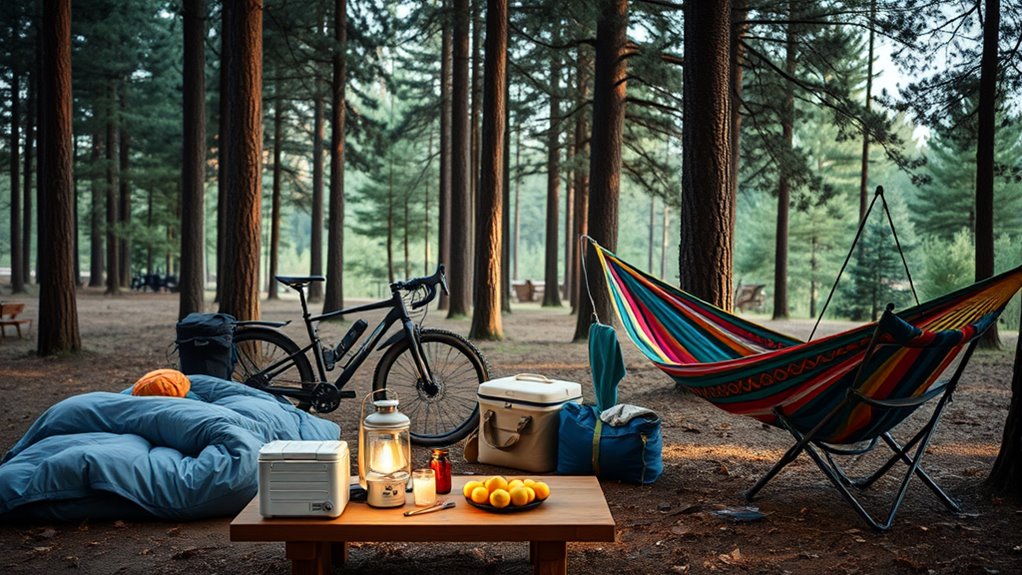
While you’re out enjoying the great outdoors on your bike camping trip, comfort and convenience items can greatly enhance your experience.
Having the right gear makes all the difference, so consider packing these essentials:
- Tarpaulin – This versatile item serves as a shelter, ground mat, or gear cover, ensuring you stay dry and protected.
- Camping Chair – A comfy chair allows you to relax during breaks and meals, preventing back pain on those long rides.
- Head Torch – With hands-free lighting, you can easily cook or set up your tent after dark, ensuring safety and ease.
Don’t underestimate these comfort and convenience items; they’ll make your adventure much more enjoyable!
Frequently Asked Questions
What Type of Bike Is Best for Bike Camping?
When you’re choosing a bike for camping, consider a touring or adventure bike.
These bikes offer stability and comfort for long rides on varied terrain. They usually come with racks for carrying gear and have wider tires for better traction.
If you’re planning to tackle rough trails, a mountain bike might work, too. Just make sure it’s equipped for carrying your camping essentials, so you’re ready for your adventure!
How Do I Prevent Gear Theft While Camping?
To prevent gear theft while camping, you need to be proactive.
Always lock your bike and gear with sturdy locks, preferably in well-lit, populated areas. Use lockable bags or pouches for valuables and keep your essentials close while you sleep.
When setting up camp, position your gear near your tent. Consider using a theft deterrent device, like a GPS tracker, for peace of mind.
Finally, trust your instincts; if something feels off, stay alert.
Can I Bring My Pet on a Bike Camping Trip?
Absolutely, you can bring your pet on a bike camping trip!
Just make certain they’re comfortable with biking and can handle the distance. Use a sturdy pet carrier or a specially designed bike trailer to keep them safe.
Pack their essentials like food, water, and a leash. Always check the camping regulations to verify pets are allowed.
With a little preparation, you and your furry friend can have an unforgettable adventure together!
What Are the Best Weather Conditions for Bike Camping?
You might think any weather’s fine for bike camping, but that’s not true.
Ideal conditions are mild temperatures, low humidity, and minimal wind. You’ll enjoy your trip more if it’s sunny but not scorching, around 60-75°F.
Check the forecast to avoid rain and storms, which can ruin your experience. Remember, you want clear skies to soak up the scenery and enjoy your ride without worrying about getting soaked or blown off course.
How Do I Stay Motivated During Long Rides?
Staying motivated during long rides can be challenging, but you can boost your spirits by setting small goals. Break the ride into manageable segments, rewarding yourself for each milestone you reach.
Listen to your favorite music or podcasts to keep your mind engaged. Surround yourself with fellow cyclists for encouragement, and remember to enjoy the scenery.
Keeping a positive mindset and focusing on the joy of riding will help you push through those tougher moments.
Conclusion
As you gear up for your bike camping adventure, remember that every item on your checklist is a stepping stone toward unforgettable memories. Imagine the thrill of pedaling under starlit skies, the warmth of a campfire, and the camaraderie of sharing stories with friends. With the right preparation, you’re not just packing gear; you’re crafting an experience that’ll linger in your heart long after the journey ends. So, hit the road and let the adventure begin!
